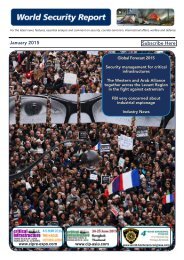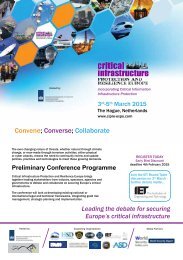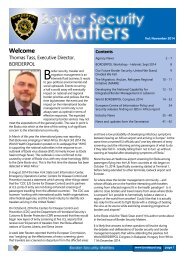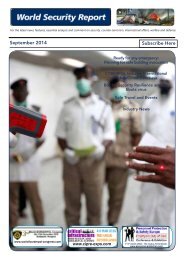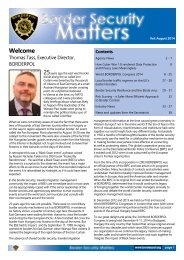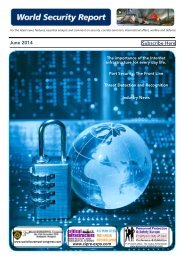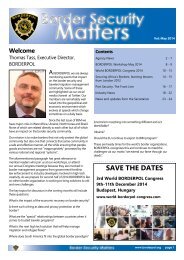World Security Report April 2014
World Security Report is a bi-monthly electronic, fully accessible e-news service distributed to 38,000 organisations globally. It tracks the full range of problems and threats faced by today’s governments, armed and security forces and civilian services and looks at how they are dealing with them. It is a prime source of online information and analysis on security, counter-terrorism, international affairs, warfare and defence.
World Security Report is a bi-monthly electronic, fully accessible e-news service distributed to 38,000 organisations globally. It tracks the full range of problems and threats faced by today’s governments, armed and security forces and civilian services and looks at how they are dealing with them. It is a prime source of online information and analysis on security, counter-terrorism, international affairs, warfare and defence.
Create successful ePaper yourself
Turn your PDF publications into a flip-book with our unique Google optimized e-Paper software.
Interview - The Evolution of the Vulnerability Assessment<br />
a 3D model of the site based on<br />
satellite imagery or imported GIS<br />
and CAD data. The model can<br />
include the interior and exterior<br />
features of structures, access points<br />
and entrances, natural features,<br />
and the placement of both active<br />
and passive barriers and detection<br />
tools. Then the AVERT model is<br />
used to run simulations on a variety<br />
of risks, from breach teams to<br />
insiders and weather hazards.<br />
For man-made threats, such<br />
as terroristic events, AVERT<br />
measures the strengths and<br />
weaknesses of a site’s security<br />
by identifying the most effective<br />
paths that adversaries would use<br />
to penetrate the site’s defenses<br />
and reach a user-specified<br />
objective. AVERT uses Monte<br />
Carlo simulation to attempt to<br />
defeat the security systems of a<br />
site model. Parameters can easily<br />
be changed within the model to<br />
address a wide range of security<br />
system configurations, targets and<br />
adversary objectives. This variance<br />
creates a high degree of real-world<br />
fidelity by covering a large number<br />
of possible tactics and strategies<br />
for adversaries, generally aimed at<br />
finding the most vulnerable parts<br />
of the security system.<br />
Once the vulnerabilities and<br />
pathways have been identified<br />
and analyzed, the user can change<br />
and test new modeled defenses<br />
and procedures to optimize their<br />
security posture. In addition to<br />
optimizing a facilities’ security,<br />
AVERT can optimize security<br />
budgets by allowing the user to<br />
test and choose which security<br />
“we knew that convincing people to adopt<br />
such a new approach would be hard”<br />
system, or combination of systems,<br />
were proven most effective and<br />
compare them to the cost. This<br />
allows for cost-benefit analysis<br />
before expensive changes are<br />
made to the security of the site.<br />
But does it work?<br />
“We knew that convincing people<br />
to adopt such a new approach<br />
would be hard, so have we spent<br />
a lot of time working with experts<br />
to validate our solution”, explains<br />
Robert Scott.<br />
To that end, ARES <strong>Security</strong><br />
submitted AVERT to the US<br />
Departments of Energy and<br />
Department of Defense for<br />
rigorous testing and validation.<br />
These organizations have verified<br />
the effectiveness of the solution<br />
and have chosen the system to<br />
secure some of their most critical<br />
assets. In addition, the AVERT<br />
software earned the United States<br />
Department of Homeland <strong>Security</strong><br />
(DHS) SAFETY Act designation<br />
and certification. The certification<br />
provides government issued<br />
liability coverage and protection<br />
for future acts of terrorism against<br />
the United States.<br />
Non-government organizations<br />
have also reviewed AVERT’s risk<br />
assessment approach. In 2012,<br />
the United Kingdom’s National<br />
Nuclear Laboratory and ARES<br />
<strong>Security</strong> signed a collaboration<br />
agreement. As the first customer<br />
outside of the United States,<br />
NNL worked with ARES to test<br />
and develop the AVERT product<br />
to simulate potential assaults on<br />
NNL’s own Central Laboratory<br />
facility on the Sellafield site in<br />
Cumbria. In 2013, NNL published<br />
a position paper entitled, “A<br />
New Approach for Assessing<br />
Operational Nuclear <strong>Security</strong><br />
Performance.” that reviewed the<br />
findings of their AVERT pilot. The<br />
conclusion of the paper stated that<br />
the computer-based quantitative<br />
modeling and simulation approach<br />
could represent a “sea-change”<br />
in the way UK nuclear security<br />
vulnerability is assessed for<br />
compliance in the future. Today,<br />
NNL and ARES work together<br />
to offer the AVERT solution and<br />
domain expertise to nuclear and<br />
other key critical infrastructure<br />
sectors where defense against<br />
terrorist or similar threats is a major<br />
consideration.<br />
“Over the past year, we have<br />
implemented the solution to<br />
several commercial organizations<br />
that provide and protect critical<br />
resources” says Robert Scott, “We<br />
are looking forward to adding<br />
their case study results to our list of<br />
findings to prove the AVERT story.”<br />
23 - <strong>World</strong> <strong>Security</strong> <strong>Report</strong> worldsecurity-index.com



